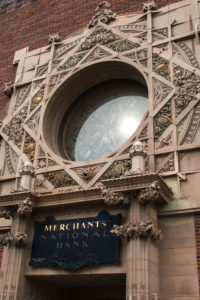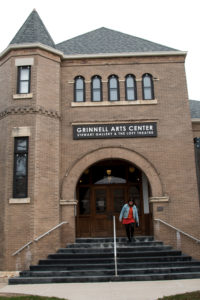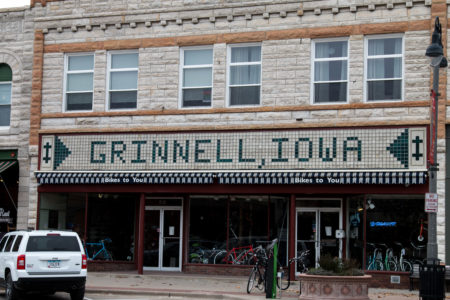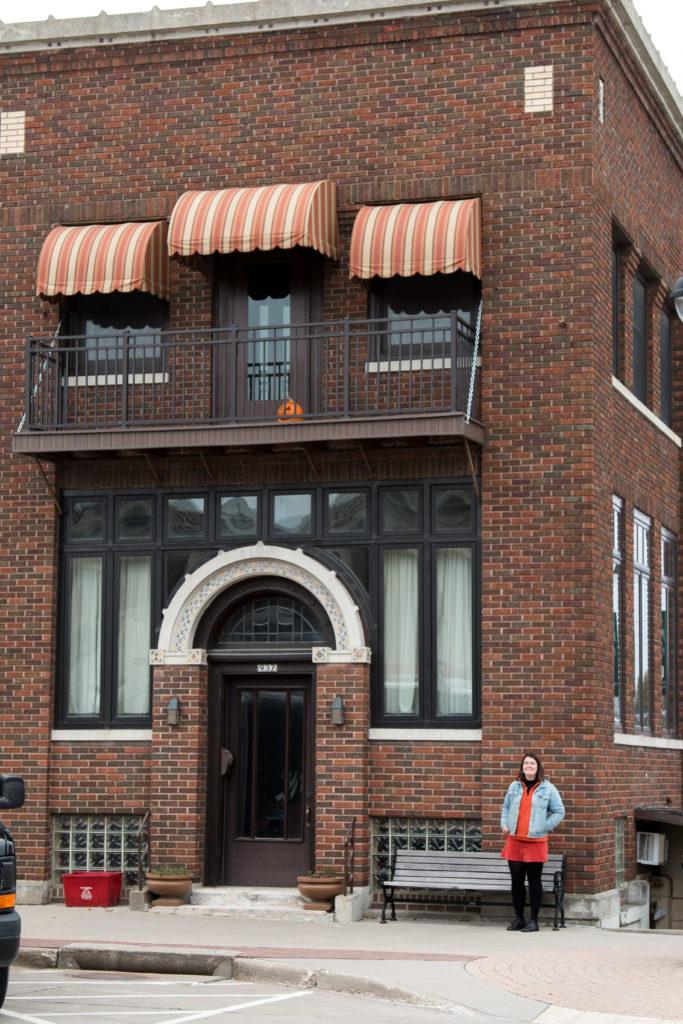By Chloe Wray
wraychlo@grinnell.edu

The S&B’s Chloe Wray took a stroll along the Chamber of Commerce’s Historical Grinnell Walking Tour. With fresh eyes, she saw downtown in a brand new context.
When I came to Grinnell last spring, visiting for an admitted students weekend, I strayed from the scheduled events to walk downtown and see the small town beyond the College’s campus. On that Sunday evening in mid-April I don’t remember seeing another person, and I walked down the middle of the street without meeting a car. Although ghostly, the emptiness allowed the focus to be on the buildings and the atmosphere they created, without the distracting influence a bustling downtown may have had. While I half expected a ball of tumbleweed to roll down the empty street like a scene out of a wild west film, the building facades were far from simple saloons and general store fronts. Instead they were architecturally complex with an apparent history. I remember walking past the Strand and seeing “Grinnell, Iowa” tiled above the bike shop.

Since my initial excursion downtown last April, and on subsequent and frequent walks since my arrival here three months ago, I have attempted to explore the town and get to know the community’s people and history.
Recently, the Grinnell Area Chamber of Commerce put out a series of walking tours through their initiative “Get Into Grinnell,” a resource for discovering all that the community has to offer for longtime residents, students and visitors alike. The tours offered cover history, architecture and the arts. All three can be found on the “Get Into Grinnell” website, under “Things to Do”.
Most of my exploring consists of imagined histories and musings of why and how buildings came to be. The history tour countered some of my assumptions, expanded on others and introduced me to a few buildings I had not previously known.
The first stop on the historical tour’s eight listed sites within a two-block radius of each other downtown was the Merchants National Bank. On the corner of 4th Ave. and Broad St., this bank is literally Grinnell’s jewel box. It rightfully receives notoriety as a design of renowned architect Louis Sullivan, one of several “jewel box” banks that he designed across the Midwest. Both the exterior and interior are subject to an enormous amount of detail. Each time I walk past, I notice something more than the time before, stunned by the jewel-like shapes that are replicated on the planters and crosswalks all around town.

My favorite bench downtown is situated on the west side of Central Park, across from Solera, and what is known as the Phoenix Block. All the time I’ve spent on this bench and I’ve never known what I was looking at. The Phoenix Block earned its name after a fire broke out in 1889 between Commercial St. and 4th Ave. on Broad St., and practically all the original buildings were heavily damaged. Through repair and reconstruction, the block was restored, rising out of the ashes like a Phoenix.
Like the Phoenix Block, which was originally primarily wood framed buildings, the block north of 4th Ave. caught fire in 1891. The light stone buildings were built as a result, across from the historic Stewart Public Library, now the Grinnell Arts Center. At the top of the buildings that now house Saints Rest and the bike shop are names. Likely these are the names of the original owners and a detail worth further investigation.
The Old Grinnell Register Building at the corner of Broad St. and 5th Ave. is slightly run down, now apartments. The Register and the Herald, combined since 1936, are housed on 5th Ave. I had noticed the slightly dismal side staircase in contrast to the desirable glass brick windows leading down to the basement before, but had never noticed the tiles that, while chipped, still adorned the door frame and windows.

Most students have probably been into McNally’s, marveled at the old model-T car sitting in the eating area, and have given it little thought. Had I been paying attention previously, the photos on the walls, as well as the wheeled wings that sit above the door on the exterior should have been indicators to me that the building was once a car dealership.
Down the street from McNally’s, the Masonic Lodge is a prominent building, striking in size and architectural detail, and full of Freemasonry mystery. Down the street, Victor’s Appliance and Mattress has always had plenty of beds, previously housing workers from local factories.
On 4th Ave., between Broad St. and Main St., lies Grinnell’s oldest building. Tucked between a row of buildings that all bear plaques marking their designation on the National Register of Historical Places is 807 4th Ave. An empty store front, the small two-story building is old, but not immediately remarkable.
Sites like 807 4th Ave. and the old Register building are just a few of Grinnell’s hidden gems, unmarked albeit their markers of historical designation. Much of the downtown has been preserved through these designations, making it far easier to imagine what life was like 100 years ago for Grinnell residents. Of course, at the turn of the century, far fewer storefronts stood empty as they do today. As I walk around downtown, I wonder if the first step to revitalizing downtown and making it a place students want to go is simply a matter of getting students there in the first place.






























































